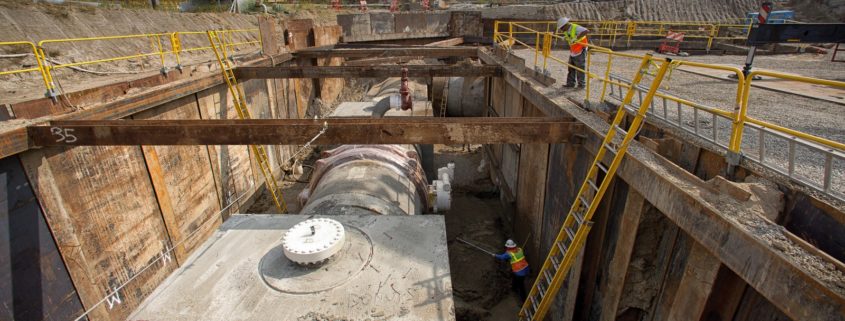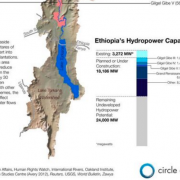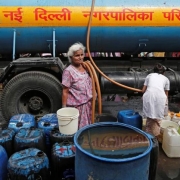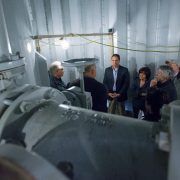Panel Recommends Changes to Two-Decade-Old EPA Water Affordability Guidelines
The EPA has heard similar suggestions before. Will the agency act decisively this time?
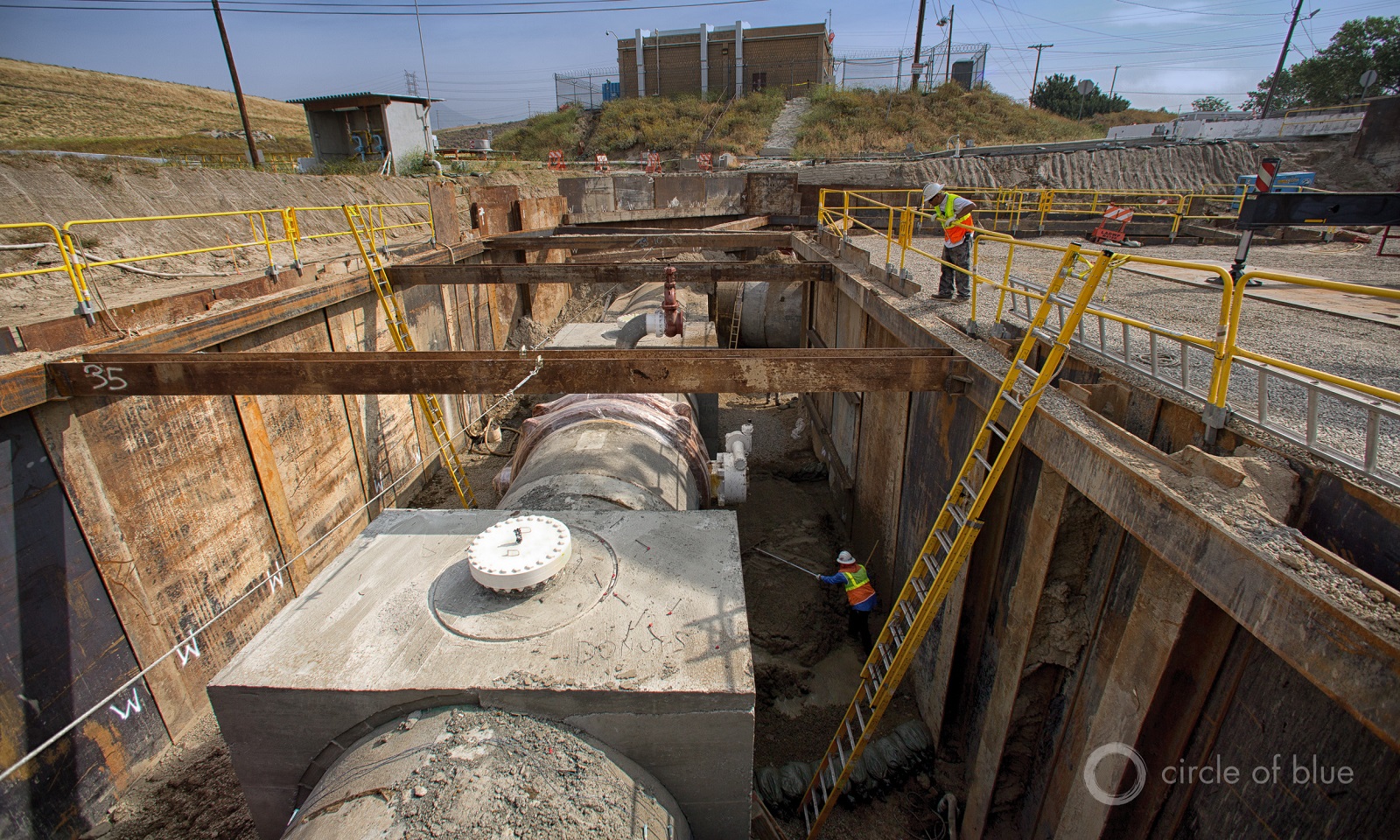
Los Angeles Department of Water and Power workers install a steel trunk line that will feed a ultraviolet treatment plant that will be completed in 2019. Photo © J. Carl Ganter / Circle of Blue
By Brett Walton, Circle of Blue
In a highly anticipated report, a panel chartered by Congress to advise public agencies on effective governance recommends that the U.S. Environmental Protection Agency revise how it appraises financial burdens when communities are required to upgrade water and sewer systems.
Observers say that the revisions, if the EPA accepts them, could change the agency’s permitting and enforcement of municipalities under the Clean Water Act and Safe Drinking Water Act, the bedrock federal environmental laws that occasionally result in multibillion-dollar modifications of water treatment facilities. That means communities could have more time to complete required projects.
“It’s a big deal,” Chris Hornback of the National Association of Clean Water Agencies, a trade group, told Circle of Blue, referring to the report’s recommendations and the enforcement changes that might come if the EPA revises its water affordability guidelines.
Even Congress recognizes that the rising cost of water and sanitation service in the United States requires new approaches by utilities and regulators. Lawmakers, in the 2016 budget deal, ordered the National Academy of Public Administration, an organization that works to make government more effective, to evaluate the EPA’s water affordability guidance and suggest improvements.
NAPA’s 233-page report was finalized in October. It contains 21 recommendations that range from better communication between headquarters and regional offices to helping communities develop customer aid programs for poor households. It also includes guidelines for utilities that want to look holistically at clean water investments, a process the EPA calls “integrated planning.”
The core of the report, however, is four suggestions for improving the EPA’s affordability calculations. The calculations are required for infrastructure projects that bring cities into compliance with federal clean water statutes.
With the help of NAPA’s professional staff, five academy fellows wrote the report. The chair, Stan Czerwinski, was the former chief operating officer of the National Governors Association.
Water utility experts from trade groups and academia praised the panel for a thorough and nuanced assessment that was informed by hundreds of interviews with water officials and policy leaders, several roundtable discussions, and industry surveys.
“Their critique of the status quo is spot-on,” Manny Teodoro, a public policy professor at Texas A&M, told Circle of Blue.
Outdated Affordability Measurement
The status quo to which Teodoro refers is a 1997 document that guides the agency in its approach to combined sewer overflows, as well as broader planning “frameworks” that were published in 2012 and 2014.
Combined sewers, common in the Midwest and New England, are systems that carry both sewage and stormwater. They are designed to spill waste into rivers and lakes when the system’s flow is too strong, usually during heavy rain. Separating these systems to reduce the pollution load in waterways has been crushingly expensive for some cities, and water and sewer bills have soared.
In evaluating whether a community could pay for a project, the EPA relied on two measures: a “residential indicator” to show household ability to pay, and a “financial indicator” to reflect the utility’s debt load and operating costs.
The residential indicator was based on the city’s median household income (MHI). If the cost of an average sewer bill did not exceed two percent of MHI, then the project was deemed affordable.
The NAPA panel and those with whom it consulted agreed that MHI is inadequate for measuring affordability. It is a blunt tool, one that masks severe financial burdens in the poorest households. In Baltimore, for instance, a quarter of the population earns less than the federal poverty line. As incomes in the United States have diverged, the middle is increasingly unrepresentative of the country as a whole.
Respondents and the panel also agreed that all water costs — drinking water, sewer services, and stormwater — should be included in affordability calculations.
NAPA was not prescriptive in its recommendations. The report acknowledges that, given the wide variation in the nation’s tens of thousands of water and wastewater providers, the EPA will need flexibility in how it writes and enforces permits. But the agency also needs a common starting point for evaluations.
Instead of a replacement metric for MHI, the panel offered five attributes that new guidance should reflect: calculated from public data, clearly defined, easy to understand, reliable, and comparable between utilities.
“These are all sound recommendations that should improve regulatory implementation if EPA and state-level regulators take them seriously,” Teodoro said.
“We look forward to using this information to help communities and utilities fund their infrastructure needs while ensuring services remain affordable,” EPA spokeswoman Tricia Lynn told Circle of Blue. Lynn said that the EPA agrees with many of the recommendations in the report, but would not elaborate on specific recommendations.
Unanswered Questions
Defining or measuring affordability is one task. Acting on it is another. A more lenient definition from the EPA means that communities may approach unaffordable rates more quickly and thus be granted more time to plug leaky sewers and build mammoth cisterns to hold back rainwater. Instead of 15 years to curb sewage discharges, a city may get 25 years or 30. The system improvements will still be required, just farther down the road, Hornback said.
The question that lingers is still, how to pay for it? Delaying a project for a few years may allow a community to identify a cheaper solution. But it may not. Federal grants for such projects largely dried up in the 1980s, though low-interest loans are still available and certain states such as California and Texas have stepped in with significant state funding. Philadelphia has pioneered a water rate based on household income, and other cities are considering similar measures.
Regulators, advocates, and others worry about two Americas for water quality: wealthier communities that can afford to operate and maintain their systems to the highest standards and subsidize those at the bottom; and poorer areas where drinking water that meets federal standards is available only at a spigot outside town hall. Those concerns cannot be allayed simply by changing the affordability criteria.
Perhaps the most significant question is whether the EPA will act on the report’s recommendations. Hornback recalled that the NAPA recommendations are not substantially different from ones made a decade ago by the EPA’s internal advisory committee.
“The reliance on median household income only may disguise the impact of income distribution and poverty rate for many utilities,” the Environmental Financial Advisory Board wrote in May 2007.
How the EPA acts on the NAPA report remains to be seen, he said.
This story has been updated since first publication with comments from the EPA.
Brett writes about agriculture, energy, infrastructure, and the politics and economics of water in the United States. He also writes the Federal Water Tap, Circle of Blue’s weekly digest of U.S. government water news. He is the winner of two Society of Environmental Journalists reporting awards, one of the top honors in American environmental journalism: first place for explanatory reporting for a series on septic system pollution in the United States(2016) and third place for beat reporting in a small market (2014). He received the Sierra Club’s Distinguished Service Award in 2018. Brett lives in Seattle, where he hikes the mountains and bakes pies. Contact Brett Walton

